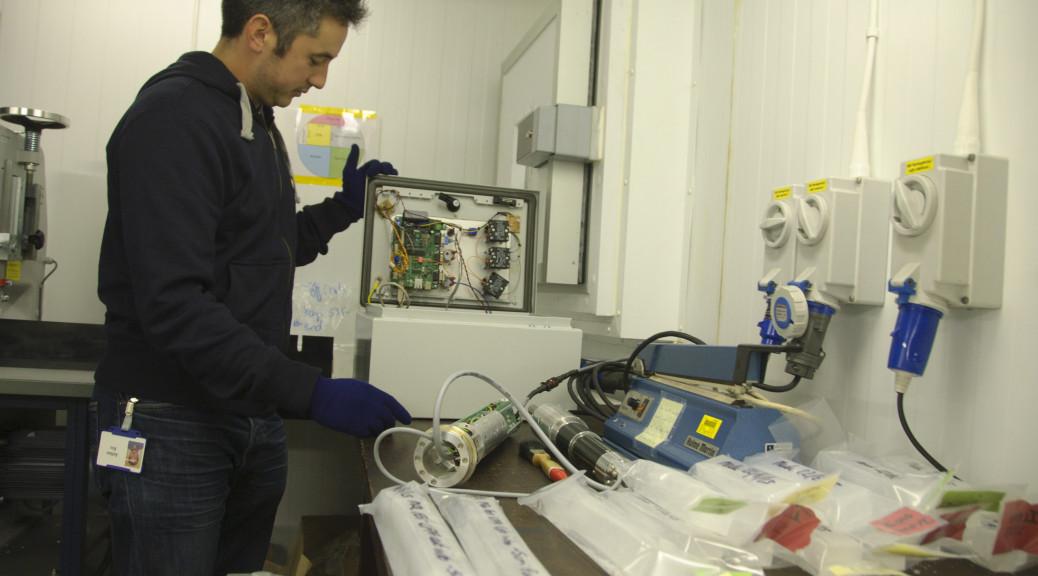There is no visible horizon in the waters beneath the Ross Ice Shelf. So electrical engineer Jim O’Sullivan built an artificial one for the pilot of the submersible remotely operated vehicle (ROV) that he and a team of scientists were testing there in 2008. The team didn’t lack for data: The ROV’s orientation, speed, and depth were numerically displayed on the pilot’s screen. But it is difficult to convert numbers into spatial awareness. The ROV was at risk of crashing into the delicate creatures, such as sea spiders, that it was supposed to be observing.
Fortunately, O’Sullivan had come across a similar problem in a different setting: aviation. As a pilot, he had an instrument rating, “which was useful for understanding how to navigate without being able to see,” he recalls. When flying blind, pilots use half a dozen different instruments to maintain their situational awareness, including an artificial horizon. O’Sullivan found open-source software that could convert the ROV’s telemetry data to display an artificial, underwater horizon. This example of engineering on (and under) “the Ice,”—as Antarctica is known—demonstrates the need for ingenuity and improvisation beyond anything training can provide.
In fact, those characteristics are precisely how British Antarctic Survey (BAS) engineer Julius Rix got his job: “My boss told me I got my first job with him because of my hobby working on old cars,” Rix says. Unlike O’Sullivan, who went to Antarctica as a contract engineer for a one-time gig and now advises startups in and around Palo Alto, Calif., Rix has grown increasingly involved in Antarctic engineering. Rix got that first job maintaining ionosphere-measuring equipment at Halley Research Station on the Brunt Ice Shelf in 2008 after doing a Ph.D. in vehicle dynamics. After two years, he took a medical-imaging job in the United Kingdom. But his old boss lured him back a few years later to move the equipment from the old Halley station to a new one. Now he is a staff engineer at the BAS Cambridge office and has returned to Antarctica twice with a scientific team searching for the world’s oldest ice.
At Rix’s Cambridge office, a tangle of hats, gloves, goggles, and giant fuzzy boots nearby attest to his frequent visits to a nearby walk-in freezer, with ice core samples and drilling equipment. In between visits to Antarctica, Rix must troubleshoot the drilling equipment and try to anticipate what might go wrong in the field, packing accordingly. Still, teams are unlikely to anticipate everything and must be prepared to adapt. “Learn as many skills as you can,” he advises prospective Antarctic engineers.
Recent job ads for electrical or electronics engineering jobs in Antarctica confirm that while jobs are available for those seeking an unusual workplace, a diversity of experience and willingness to embrace difficult living conditions are prerequisites. Engineers on the Ice do everything from building new facilities to maintaining telescopes and tagging along with scientific teams for temporary projects, as O’Sullivan did. The diversity of roles means that many kinds of engineers can go, but be warned: The competition is stiff.
Several nations operate Antarctic research programs. Interested applicants should monitor these programs’ websites and those of any private contractors supporting national programs. Hiring tends to be seasonal: Opportunities spike for the Antarctic summer. Another method is to seek out scientific research projects that may need an engineer and approach them directly. O’Sullivan got his field gig through an introduction from a mutual contact.
Both O’Sullivan and Rix emphasize the difficulties that come from Antarctica’s remoteness. “Probably the isolation was the hardest part,” O’Sullivan says. That goes for digital communication almost as much as physical isolation: Few satellites dip that far south, and visitors must be prepared for limited Internet bandwidth. Rix noted that his wife didn’t like his being away so long and the uncertainty of when he would return.
Still, Rix is looking forward to going back and seeing new parts of the continent with the drilling team. And O’Sullivan says he’s very glad he went. “I was surprised at how alive it is in the water down there,” he says. “It looks very barren on the surface in Antarctica, but the oceanic life is quite vibrant.”
